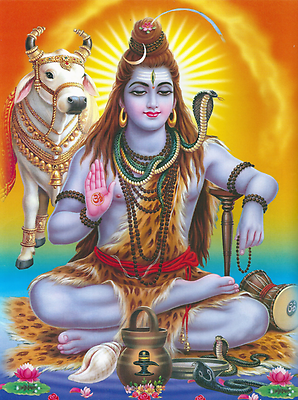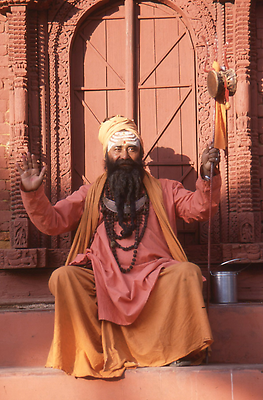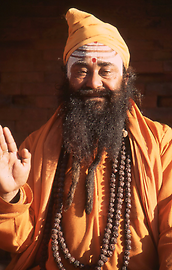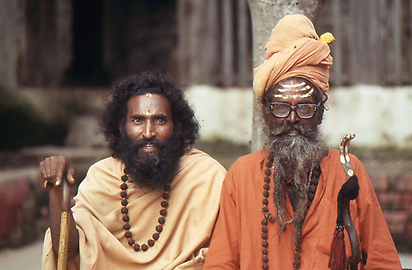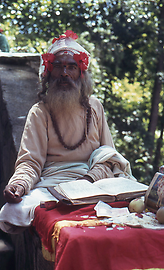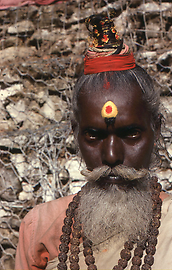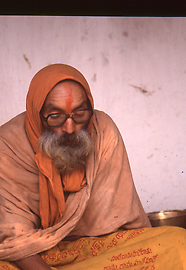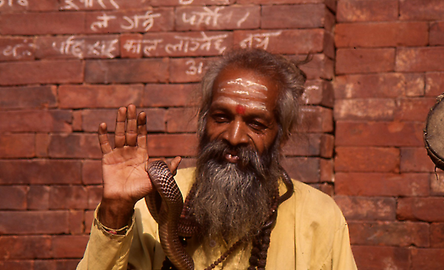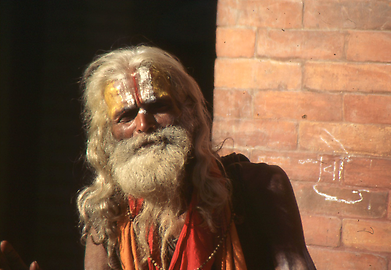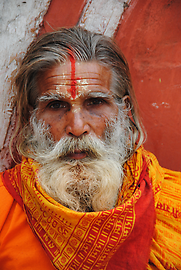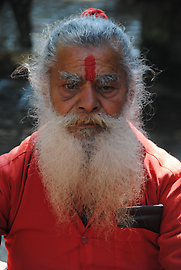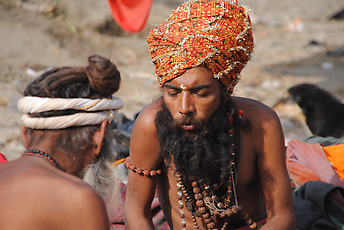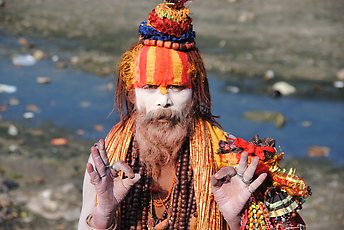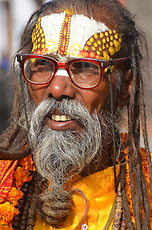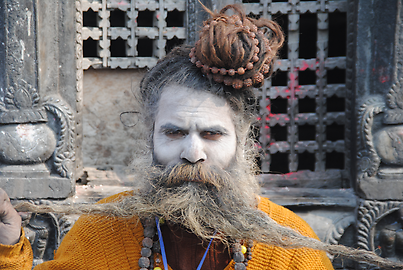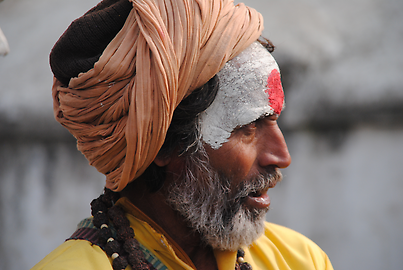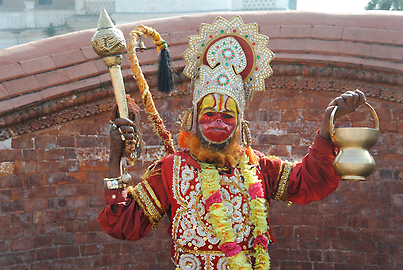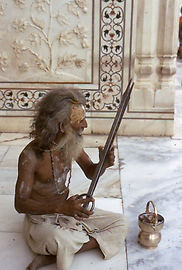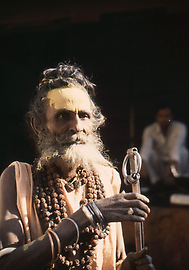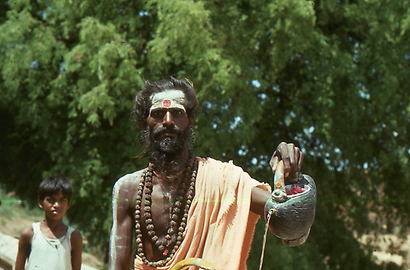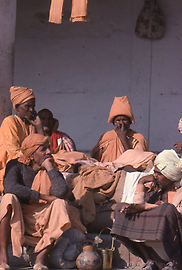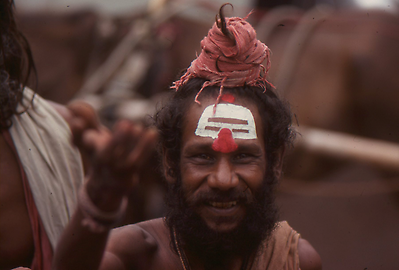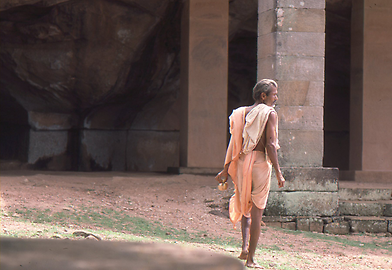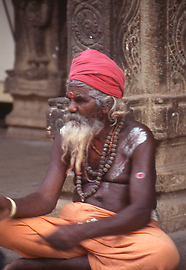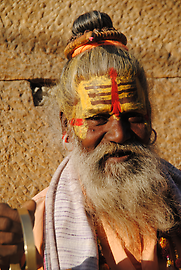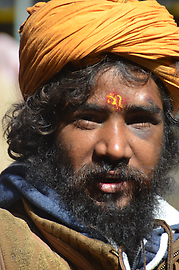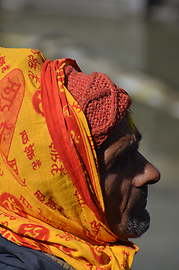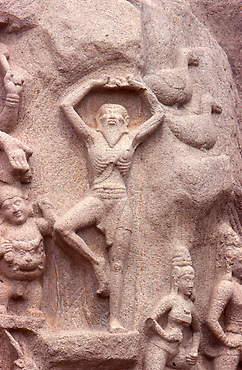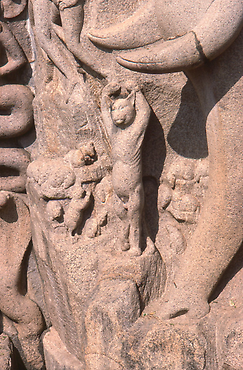Holy men in India and Nepal#
ByAll photos were taken by the author in India and Nepal in the period 1974 to 2015 and are part of the archive "Picture Flood Jontes".
In the streets of India and Nepal, both countries in southern Asia and dominated by Hinduism, among the city and village population, people of different outer appearance and behavior are noticeable. Indians respect and fear them, because they are outside the conventions of society. These are the so-called Sadhus, often wrapped in orange-red robes and with long and matted locks of the hair (jata), eye-catching painted forheads and ashes brushed over the whole body. Begging or meditating, they can be observed in temples or nearby. Shiva-Sadhus wear also prayer chains from Rudraksha-seeds.
In old Indic, Sadhu has the meaning of „good“ and „good and holy man“. These are people ideally lead an ascetic life by moivng around permanently. The are called "Sannyasin", persons not longing after any worldy possessions. The laity address them as "uncle" (Baba). They are also called Svami standing for Lord or Master. Female representatives are called Sadhvi. In Hinduism, their way of life is considered to be one of the many ways to God. To make their meditation more effective, many of them smoke hashish (ganja) with the approval of the authorities.
Hinduism recognizes four stages of the ideal human life, representing the individual periods of life: childhood, working life, family formation and handing over what has been created to the next generation and separation from the society as last stage. In this last period, you leave everything behind and you begin to search for knowledge and redemption of the eternal cycle of re-birth (moksha).
Today, there are four to five million Sadhus in India and Nepal. Their existence can range from strict withdrawal from the world and strictest asceticism to begging demandingly or friendly attention by offering blessings. Many of them are masters of yoga techniques and their physical performances can be amazing. They form also tight or loose communities. Monastic communities are relatively seldom. In such cases you live in ashrams or in temples like in Varanasi / Benares Vranasi, India . The most important festival for Sadhus takes place in Kumbh Mela in Allahabad, where the two rivers Ganges and Yamuna merge. One the most important pilgrimage site of Shivaism is the temple of Pashupatinath near Kathmandu in Nepal.
Hinduism is not only a religion of innumerable gods, a poytheism. The science of religion calls the pratised forms of worship henotheism, meaning that one of the deities is the highest one for a person and is worshiped accordingly. Most worship Vishnus as the preserver (i.e. Vaishnava) and Shivas as the destructive one and the creator (i.e. Shaiva). A painted symbol on the forhead of a layperson shows which form of worship is practiced. The Sadhus can also be assigned to one or the other group, respectively.
You become a Sadhu by opting for this way of life. You follow a guru and learn from him the forms of meditation and worship practices. Then, you start journeying and perhaps, someday you become also a guru.
Among the Hindu society, there is a especially radical group, called Agoris. This name derives from one of many honorary titles of Shivas, Agora, the fearless. The agories reject all social and religious conventions. A human skull is their eating, drinking and begging bowl. There are about one thousand of them. Most of them live in the holy town Varanasi / Benares. They maintain secret rituals and tantric practices to express their complete victory over worldy concerns. It is even said that they eat meat from human corpses and dress in shreds of burial robes. They live in cremation grounds outside of suburban settlements. They drink alcohol and have sex with Yoginis, somehting beyond all religious and ethical ideas of Hinduism. Their dead bodies are not cremated, but buried or given over to the rivers.
One of the oldest pictures of a Sadhu in a characteristic meditation posture can be found on a famous, giant stone relief on the Coming down of Ganges (Gangavatan) from the 7th century in Mahabalipuram, in southern India. King Bhagiratha was meditating in strictest asceticism until God Brahma fulfilled his desire for water for dried out world. Bhagriratha asked for sending the holy river Ganges from heaven to earth. On the stone relief, the king is shown with an emaciated body, standing on one leg and raising the arms to the sky. The artist of this masterpiece had a lot of humor. Both a cat and a mouse are imitating the meditation posture on the relief.
In his form of Shiva Shankara, Shiva appears also as an ascetic surrounded by nature. He is sitting in medidation posture on a leopard skin, is putting his arm on a meditation crutch with a cobra coiling around his neck. Out of his topknot, that has the form of a crescent moon, rises the river Ganges. His blue skin color he owes to the fact that after the mythical churning of the milky ocean, a poison was left that would have killed the world and everything that had been created, if the God had not drunken it. Therefore, he is called Vishpan, the drinker of poison. Shiva is accompanied by his riding animal, the holy bull Nandi.
This kind of devotional pictures of all sizes shows the pantheon of India in a style that was brought to India by Christian missionaries in the 19th century. They brought lithografically colorful pictures mostly from Bavaria. For over a hundred years this style is still in use. In North and South India pictures are produced in huge quantities as popular pictures. In recent years, the style of these chitras is approaching the style of painted film posters. The writer of this essay owns a collection of thousands of sheets.
